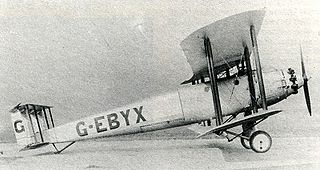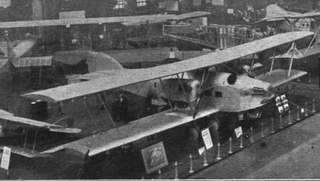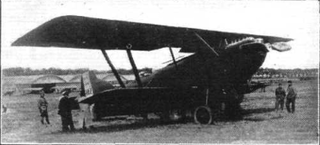
The Farman F.60 Goliath was a French airliner and bomber produced by the Farman Aviation Works from 1919. It was instrumental in the creation of early airlines and commercial routes in Europe after World War I.

The Bristol Bloodhound was a British two-seat reconnaissance/fighter aircraft designed and built by the Bristol Aeroplane Company as a possible replacement for the Bristol F.2 Fighter for the Royal Air Force. It was unsuccessful, only four prototypes being built.

The Farman F.120 and its derivatives were a family of multi-engine airliners and bombers of the 1920s built by the Farman Aviation Works in France.

The Bristol Badger was designed to meet a British need for a two-seat fighter-reconnaissance aeroplane at the end of World War I. Despite the 1918 Armistice, three Badgers were delivered to the Air Board to develop air-cooled radial engines, particularly that which became the Bristol Jupiter; two other Badgers were also built.

The Vickers Vellore was a large biplane designed as a freight and mail carrier, in single-engined and twin-engined versions, which saw limited use as freighters and long-range experimental aircraft. A final variant with a broader fuselage, the Vellox, was built as an airliner.

The Dyle et Bacalan DB-10 was a heavy night bomber, designed in France and flown in 1926. It was a twin engine, high wing, metal frame monoplane, distinguished by a very thick centre section wing which formed the forward fuselage and housed the engines.
The Farman F.30A C2 was a two-seat biplane designed as a fighter in France in 1916 and powered by a single, water-cooled radial engine. It showed poor flight characteristics and only one was built, though it was modified twice. It should not be confused with the similarly named Henry Farman HF.30 of 1915, a completely different aircraft which was used in large numbers by the Imperial Russian Air Service.
The Farman F.250 was a small, four passenger single engine low cantilever wing airliner built in France in 1931. The single example built was bought by an airline but was little used, owing to stability issues.

The Farman Moustique is a family of French monoplanes built by the Société des Aéroplanes Henry et Maurice Farman at Billancourt.

The Farman FF 65 Sport was a French built light biplane, with a single engine and tandem seats, intended for sport and touring. First flown in 1919, it achieved modest sales at home and abroad in the early 1920s. Two unusual modifications produced a biplane glider and a low aspect ratio parasol wing machine.
The NVI F.K.29 was a small Dutch biplane transport, carrying two passengers who boarded after the nose, with its single engine and fuselage, had been swung open. It was intended to link small local fields to main airports.

The NVI F.K.35 or Koolhoven F.K.35 was a two-seat fighter aircraft built in the Netherlands during 1926. It was completed and exhibited but, through a combination of ground accident and financial problems, never flown.

The Hanriot H.26 was a French single seat fighter aircraft prototype completed in 1923. Only one was built.

The Potez VIII was a French training aircraft which first flew in 1920. Originally it had a very unusual vertical inline engine and a four-wheeled undercarriage, though the production version was more conventional.

The Potez XVIII was a French airliner from the early 1920s, a three-engine biplane carrying up to twelve passengers.

The Potez 28 was a French aircraft designed in the 1920s to set distance records, built in both sesquiplane and monoplane versions. Only two were completed but both set several long distance records.

The Caudron C.27 was a French biplane, a two-seat basic trainer which also competed successfully in the 1920s.
The Caudron C.91 was a French single engine biplane with an enclosed passenger cabin seating four. It first flew in 1923.

The Caudron C.23 was a French long range twin engine night bomber, flown in the last year of World War I. Post-war some machines were modified to carry passengers.
The unsuccessful French Farman F.200 of 1923 shared its type name with the 1929 Farman F.200, the progenitor of a series of parasol wing tourers. It was a two-seat touring aircraft, with a low, thick, cantilever wing. Only one was built and only briefly tested.
















